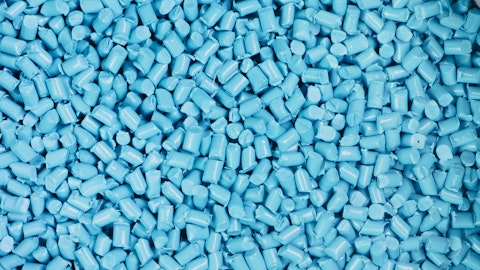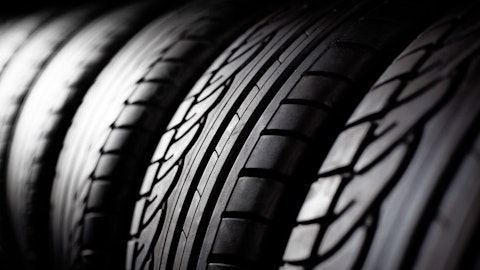Myers Industries, Inc. (NYSE:MYE) Q4 2023 Earnings Call Transcript March 5, 2024
Myers Industries, Inc. beats earnings expectations. Reported EPS is $0.29, expectations were $0.26. MYE isn’t one of the 30 most popular stocks among hedge funds at the end of the third quarter (see the details here).
Operator: Hello and welcome to the Myers Industries Fourth Quarter and Full Year 2023 Results. My name is Harry and I will be coordinating your call. [Operator Instructions]. I will now hand over to our host, Meghan Beringer, Myers Industries Senior Director of Investor Relations to begin. Please go ahead.
Meghan Beringer: Thank you, Harry and good morning everyone. Thank you for joining Myers conference call to review 2023 fourth quarter and full year results. Joining me today is Mike McGaugh, our President and Chief Executive Officer and Grant Fitz, Executive Vice President and Chief Financial Officer. Earlier this morning, we issued a press release outlining our financial results for the fourth quarter and full year 2023. We’ve also posted a presentation to accompany today’s prepared remarks which is available under the Investor Relations tab at www.myersindustries.com. This call is also being webcasted on our website and will be archived along with the transcript of the call shortly after this event. After the prepared remarks we will host a question-and-answer session.
Please turn to Slide 2 of the presentation for our Safe Harbor Disclosures. I would like to remind you that we may make some forward-looking statements during this call. These comments are made pursuant to the Safe Harbor provisions of the Private Securities Litigation Reform Act of 1995. Such statements are based on management’s current expectations and involve risk, uncertainties, and other factors, which may cause results to differ materially from those expressed or implied in these statements. Also please be advised that certain non-GAAP financial measures such as adjusted gross profit, adjusted operating income, adjusted EBITDA, and adjusted earnings per share or EPS may be discussed on this call. Further information concerning these risks, uncertainties, and other factors is set forth in the company’s periodic SEC filings and may be found in the company’s 10-K and 10-Q filings.
Now please turn to Slide 3 of our presentation, I’m pleased to turn the call over to Mike McGaugh.
Michael McGaugh: Thank you Meghan. Good morning everyone, and welcome to our fourth quarter and full year 2023 earnings call. I’ll begin with a review of our full year 2023 highlights but first, I’d like to thank all of our team members whose hard work, dedication, and day to day efforts continue to improve the strength of our company. Our team has made incredible progress transforming Meyer’s industries over the past few years. That progress is evident in our 2023 results, as we delivered improvements in operating performance and free cash flow generation, despite cyclical weaknesses in several of our end markets. We first outlined our 3 Horizon strategy shortly after I joined Myers Industries in 2020, and since then much of our team’s work has been focused on building a strong foundation for the company.
I’m pleased with the progress we’ve made so far, and I look forward to sharing even more details of our journey at our upcoming Investor Day event on March 19th in New York City. At this event, we will outline our growth strategy for Horizon 2 and the updated long term outlook for our company. We hope many of you will join us in person for this event. Now onto our full year 2023 highlights. On many measures I’m pleased with our results for the year. That said, I am less than satisfied that we did not build on the very strong results we achieved in the prior year. Starting with the positive, calendar year 2023 was one of the top years in the history of our company for earnings per share, adjusted EBITDA, and revenue. We grew adjusted gross margin, expanding at 40 basis points year-over-year to 32%.
We improved cash flow, producing $86 million in cash flow from operations and $63 million in free cash flow, a $15 million year-over-year improvement. Due to our team’s continued focus on the self-help levers of operational excellence and commercial excellence, we were able to achieve these results despite challenging end market conditions and macroeconomic and inflationary headwinds. While I’m proud of our team’s efforts in the face of challenging economic environment, I’m disappointed that on several measures, we fell short of our objectives for the year. Compared to prior year results our revenue declined just under 10% to $813 million, our adjusted EBITDA declined just over 10% to $98 million, and our adjusted EPS declined just over 17% to $1.39 per share.
On the heels of a strong 2022 where we grew EBITDA 51% and earnings per share of 73% year-over-year these 2023 results were disappointing. To improve our results we continue to implement the operational excellence and commercial excellence techniques and knowhow brought to Myers through the experienced leaders I have recruited from large cap companies. Our self-help mindset and measures are now ingrained in our company and are being institutionalized and made permanent in the best practices playbook we call the Myers Business System. This system raises the floor of our earnings potential during times of soft, cyclical end market demand as we experienced over the past year. Other, the Myers Business System is accelerating our transformation by delivering simplified and standardized work processes across our company.
As a result, when we are faced with headwinds from our end markets as we experienced in 2023, our businesses will be even more resilient than they have been historically. We already see many of the benefits of these practices. For example, despite cyclical headwinds from RV, marine, and consumer end markets, the material handling segment delivered solid fourth quarter results with strong margins. Operational excellence initiatives delivered more productivity, liberating more capacity on our assets what I’ve referred to in past calls as a hidden factory. This additional production capacity is unlocked by optimizing how we operate and schedule our assets. We expect that this improvement in productivity will allow us to continue to optimize our asset footprint and reduce fixed costs in the future.
In our distribution segment, the business did not deliver the results I expected. Fourth quarter results were disappointing, unfavorably impacted by a short term decline in sales volume and revenue, primarily due to a strategic realignment of the sales organization undertaken in the third quarter. Sales revenue and volume were also negatively impacted in 2023 due to inefficiencies from the lack of a fully integrated ERP system in this segment. These inefficiencies have now largely been remediated with the recently completed consolidation of ERP systems for the distribution segment. Longer term, both the sales force realignment, as well as the newly integrated ERP system, will enable Myers to better capitalize on its size, scale, and service level capabilities in this segment.
As consolidation occurs in the tire repair industry and as independent tire service centers are rolled up into national chains, Myers Industries is best positioned to serve these nationwide accounts. The distribution segment will also benefit from the Myers business system initiatives, just as we are now seeing in the material handling segment. Finally, we announced in early 2024 the acquisition of Signature Systems, which moves us significantly toward our Horizon 1 target of $1 billion in sales and an EBITDA margin of 15% or more, and positions us well for Horizon 2. In acquiring Signature, we have added to Myers a differentiated, profitable, high growth business. Signature represents another important step in achieving even greater end market diversification and less cyclicality in our overall results.
We believe Signature Systems is the catalyst for Myer’s transformation and will be a growth engine for the company. We continue to be excited about our growth prospects, many of which have a long-term runway and in our material handling segment, our development programs and military cases and containers, continued strong demand for our industrial products, and the success in our e-commerce sales channel efforts are all solid, multiyear growth platforms for Myers. In addition, we expect our distribution segment to demonstrate revenue growth and improved profitability as we begin to realize the benefits from the sales organization improvements and the ERP consolidation. Finally bringing Signature into the Myers family will open new growth opportunities across broader end markets.
Today our company is unrecognizable from the one I joined in 2020. Through Horizon 1, we sharpened our acquisition and integration capabilities by deliberately learning with smaller scale acquisitions. We now have more capability that enables us to pursue larger, more value creating acquisitions like Signature. Our sustained progress with commercial excellence and operational excellence, which are robust self-help measures, have raised the floor of Myer’s earning potential when some end markets are facing trough like conditions. These key elements of Horizon 1 will serve as the foundation for long term shareholder value creation as we advance through our 3 Horizon strategy in the coming quarters and years. Now, I’ll turn the call over to Grant for a detailed review of our 2023 fourth quarter and full year financial results, as well as more details on our 2024 outlook.
Grant?

Grant Fitz: Thank you. Mike. Please turn to Slide 4 for a complete summary of full year 2023 financial results. Net sales were $813.1 million, which decreased 86.5 million, or 9.6% compared to 2022, with the decline primarily driven by lower sales in the material handling segment, partially offset by increased sales in distribution segment, primarily due to the Mohawk Rubber acquisition. Adjusted gross profit was $259.9 million, and adjusted gross margin was 32%, compared to 284.1 million and 31.6% in 2022. On a dollar basis, the gross margin decrease was due to cost containment initiatives and price increases not being significant enough to offset lower volumes. Now turn to Slide 5. Our fourth quarter net sales were down $21.8 million or 10.2% compared to the fourth quarter of 2022, with lower sales across both segments.
Material handlings vehicle end market driven by RV and Marine, food and beverage, specifically agriculture, and consumer end markets continue to face meaningful headwinds in addition to the distribution segment experiencing lower volumes. Adjusted gross profit decreased $7.7 million or 11.8% as price increases in the distribution segment and cost containment efforts were not enough to offset volume decreases in both segments due to the challenging macroeconomic and inflationary environment. Adjusted gross margin for the quarter decreased 50 basis points to 30.1% compared with 30.6% in the fourth quarter of 2022. SG&A expenses decreased $8.7 million quarter-over-quarter and SG&A as a percentage of sales decreased to 20.3% compared with 22.3% in the same period last year.
The decrease is a result of lower professional services and incentive compensation. Fourth quarter adjusted operating income decreased $0.6 million or 3.6% compared to the prior year as a result of lower gross profit. Adjusted EBITDA was $21.8 million in the fourth quarter, a decrease of 0.3 million or 1.5% compared to the prior year period. Adjusted EBITDA margin increased 100 basis points to 11.4% for the fourth quarter compared to 10.4% in the same period last year. Lastly, adjusted EPS was $0.29 compared to $0.32 in the same period last year. Now please turn to Slide 6 for an overview of the performance of our segments for the fourth quarter. For the material handling segment, net sales decreased $15.3 million or 10.8% compared to the prior period.
The decrease was a result of continued demand softness across our diversified end markets with vehicles driven by RV and Marine, food and beverage driven primarily by agriculture, and consumer fuel container products being especially challenged. Material handlings adjusted EBITDA increased $2.9 million or 11.2% to $28.4 million and adjusted EBITDA margin increased to 22.4% or 440 basis points compared to the year ago period. The margin increase was driven by self-help initiatives paired with favorable sales mix partially offset by lower sales volume and pricing. Net sales for the distribution segment decreased $6.4 million or 9.1% year-over-year primarily due to lower sales volumes partially offset by favorable pricing. Distribution of adjusted EBITDA decreased $3.8 million or 76.4% to $1.2 million primarily due to the pricing actions being offset by higher product costs and lower sales volume.
Turning to Slide 7, free cash flow for the quarter of 2023 was $11.8 million compared to $15.2 million for the fourth quarter of 2022. Working capital as a percentage of net sales was flat compared to the same period last year. Capital expenditures for the fourth quarter of 2023 were $3.6 million and cash on hand at the quarter end totaled $30.3 million. For the full year, year-over-year operating cash flow increased by $13.6 million and free cash flow increased by $15 million. We ended fiscal year 2023 with a debt to adjusted EBITDA ratio of 0.7 times and as you are all well aware, our strong balance sheet enabled us to close on our previously announced $350 million acquisition of Signature Systems on February 8th. The transaction was completed on an all-cash basis and funded through an amendment and restatement of Myers existing loan agreement which maintains a $250 million revolving credit facility along with a new $400 million five-year senior secure term loan aid.
Pro forma for the Signature acquisition as of closing on February 8th, the company’s net leverage ratio was approximately three times which is within our previously stated target range. And we expect to reduce leverage to two times over the next two years through our balanced capital allocation strategy. Our combined senior secured loan agreements enhances Myers overall liquidity profile and our balance sheet remains flexible to support smaller acquisitions over the near term if acquisitions materialize at the right price. Now please turn to Slide 8 where we provided outlook for the fiscal year 2024. Starting with top line, we expect net sales to grow between 15% and 20% during 2024 as compared to the prior year. This growth will be driven largely by the impact of contributions from our recent acquisition of Signature Systems.
On an earnings per share basis, we expect diluted EPS will be between $1.03 and $1.23 per share and adjusted EPS will be between $1.30 and $1.45. Of note, these ranges are also inclusive of Signature Systems forecasted financial results. Capital expenditures in the fiscal year 2024 are expected to be in the range of $35 million to $40 million with an effective tax rate of 25%. 2024 will be an exciting year as we return to double-digit revenue growth and work to integrate the Signature business. We are focused on controlling what we can control to improve profitability amidst ongoing cyclical challenges in our end markets and look forward to discussing both our 2024 and longer term strategy and outlook with investors at our upcoming Investor Day event later this month.
Now I will turn the call back over to Mike. Mike?
Michael McGaugh: Thank you, Grant. On Slides 9 and 10, we have our legacy slides which provide an overarching view of the 3 Horizons strategy in addition to the strategic pillars of this long-term roadmap. Before we conclude today’s call, I’d like to spend a few minutes recapping the success we’ve achieved on our Horizon 1 initiatives, which will serve as a good primer for investors and analysts ahead of our Investor Day later this month. Our strategy is based on four strategic pillars; organic growth, strategic M&A, operational excellence, and having a high performing culture. Focusing on these pillars over the past several years has created a strong foundation for Myers and positioned us for improved profitability as we begin to execute on Horizon 2.
Today I’ll speak to just two of the pillars, operational excellence and people and culture. I’ll speak to all four of the pillars at our upcoming Investor Day. I’d like to go straight to the operational excellence pillar. One thing I learned during my time at Dow Chemical is that to successfully manage through cyclical end markets, self-help and operational excellence are critical and always bear fruit. Operational excellence is a self-help mechanism that is typically effective in improving a firm’s earnings capability, helping raise the earnings floor and trough and near trough conditions and expanding that earnings ceiling when times rebound. Please turn to Slide 11. Operational excellence continues to translate to improved margins through improved purchasing, improved supply chain management, and improved asset management.
These functions drove improvements through our company during fourth quarter and in 2023. As an example, our procurement group delivered raw material savings of over $20 million in 2023. As demonstrated through our margin improvements and greater cash flow generation, we’ve institutionalized these best practices which will serve to establish a floor in our earnings capacity in a period of trough or near trough demand scenarios for our RV, Marine, and consumer end markets. The work was done and operational excellence will serve us well as we move the company forward into Horizon 2. As you recall, this is an area where I’ve deployed several dozens of the hires I’ve made from large chemical and plastics companies who know operational excellence very well.
These outside hires have transformed Myers capability and continue to strengthen our company. Now moving into the people pillar, the high performing culture pillar. I believe this pillar continues to be a differentiator for Myers when compared to other small to mid-cap companies. Over the past four years, we’ve hired and deployed dozens of experts in operations, supply chain, purchasing, sales and marketing, and executive management who have the training, expertise, and seasoning for world-class large chemical, plastic, and industrial companies. It is this team and talent that has helped transform the company’s runway and potential. This team is the fundamental change of Myers industries. Indeed, we are currently facing cyclically soft demand in some of our end markets.
However, we have the company running tighter and better. When these cyclical end markets recover, we will recover stronger and faster. This team gives me confidence in our ability to navigate through these trough-like conditions for Marine, RV, and consumer. With our organic growth prospects, with our breakthrough acquisition of Signature Systems, and with our continued fortification of running our base businesses better through operational and commercial excellence, we see significant runway for shareholder value in the near, medium, and long-term. I look forward to providing more detail on our Horizon 2 strategy and direction, as well as our long-term outlook at our upcoming Investor Day later this month in New York City. With that, I would like to turn the call over to the operator for questions.
Operator?
See also 17 Countries with Highest CD Rates in 2024 and 15 Cities with the Most CCTV Cameras in the World.
Q&A Session
Follow Myers Industries Inc (NYSE:MYE)
Follow Myers Industries Inc (NYSE:MYE)
Operator: Thank you. [Operator Instructions]. And our first question today is from the line of Christian Zyla of KeyCorp. Christian, your line is now open. Please go ahead.
Christian Zyla: Thank you. Good morning, Mike, Grant, and Meghan.
Michael McGaugh: Good morning.
Christian Zyla: My first question, if I look at the sales guidance of 15% to 20%, can you just talk through what is embedded in your guidance, what are you expecting for organic growth versus the addition of Signature, and what is the cadence of that, 1Q looks to have the toughest comps, so are you thinking 1Q will be the low and then an acceleration from there?
Grant Fitz: Yeah, Christian, I would say overall that we’ve got — we’re trying to build a model that we would start to have some single digit organic growth, low to single digit organic growth with our current base businesses. And then we also have the Signature acquisition, which we would see anywhere from a 10% to 15% growth over the next year. And so within that, we do see that, that we would start to see that accelerating throughout the year, particularly on the organic growth side with the base businesses, with the cyclical markets that we’re dealing with. But overall, that’s really what translates to the guidance that we have right now.
Christian Zyla: Great. And then can you just give us a sense of how much of the quarterly sales were volume versus price, was price meaningfully higher in distribution or should we think about the two segments differently?
Grant Fitz: Yeah, price was — it was meaningfully higher in distribution. What we have essentially is that in our distribution business, we’ve made some changes as we continue to transform that business. And we have a new leader in that business that is implementing some of the disciplines that we’ve had with our material handling business. In particular with price, we do see some favorable price that we’ve been getting, something that we see of a meaningful nature for this quarter. And we would expect to see that to continue in the distribution business. In our business, particularly with our material handling, we do have some headwinds with some of the agricultural business that we have for our large seed boxes. We continue to see some pricing pressures there.
And so those two have been somewhat to some degree offsetting each other as we look at the performance from our distribution business. And then just some of the headwinds that we have with our material handling business. With that being said, I will say just from what I’ve seen with my almost a year now here at Myers, that the team is very disciplined on value-based pricing. And they really leverage this quite effectively over across the business. And I would say in particular, we’re bringing that into the distribution business now on a more expanded scale.
Michael McGaugh: Yeah. And Christian, this is Mike. If I can build on it, it’s a very good question. We had Myers Tire Supply which was a sector leader in its space. And we made the decision mid-year 2022 to acquire Mohawk, which was the next largest competitor. That was the right strategic move. As we’ve worked over the last 12 to 18 months to integrate those businesses, we’ve had to reconfigure the sales model. We really wanted to focus on larger national accounts because that’s where the customer base is headed. We wanted to have the right sales organization for the future. Then additionally, synchronizing multiple ERP systems can often be a bit of a challenge in the near-term and we face that. As I mentioned, we’ve consolidated those ERP systems at the beginning of this year.
As well, we have now consolidated a realigned sales organization that’s focused on the national accounts. What that does is the footprint of Mohawk included into Myers Tire Supply, we have the highest service level and the best footprint to almost all areas of the nation. That additional service level is going to give us more ability to get price. If we outperform and service, our customer’s willingness to pay goes up and that’s what we continue to see and we think that will be a continued trend. At the same time, the size and scope of Myers Tire Supply plus Mohawk actually gives us more purchasing leverage with our suppliers. So, if we can get a bit of an increment on price and a bit of an increment on cost, that move will continue to push the EBITDA numbers of the distribution platform into low double digits, as we’ve said.
A little bit of a setback in the back half of this year, particularly in fourth quarter for the reasons I mentioned. Obviously we’re disappointed in that, but we’re rectifying it. Largely it’s been rectified. And so that’s still an interesting business for us, given its strong competitive position. And I think, again, that will translate into the margins over the course of 2024, 2025.
Christian Zyla: Great, thanks for that color. Could you just give us a walkthrough of the end markets and what you’re seeing in 1Q, I think we’ve seen some indicators that RV and PowerSports may have modestly bounced off trough levels and show some sequential improvement, is that reflected in your business this quarter, I guess, how are you thinking about those consumer facing businesses as we progress through the year and does your guidance have any embedded recovery in those businesses?
Michael McGaugh: Yeah, if I can, I’ll take a shot at that and I’ll look to Grant. We know how to operate cyclical businesses. We know how to operate in cyclical industries. And that’s where that operational excellence really shines and allows us, I talk about establishing a floor and keeping that floor of our earnings strong. What we’re seeing is there is a little bit of a bounce off on RV and Marine. It depends on really who you listen to. The numbers are still going to be quite low in those end markets for 2024 in my opinion, and based on what we see. On the consumer side, there still is a lot of inflation. And when you have discretionary consumer goods, the products we make, whether as I talk about it as planters, mailboxes or home goods that have a higher price point or gas cans, which again, has experienced inflation, if the consumer can defer those purchases, right now we’re seeing them defer those purchases.




